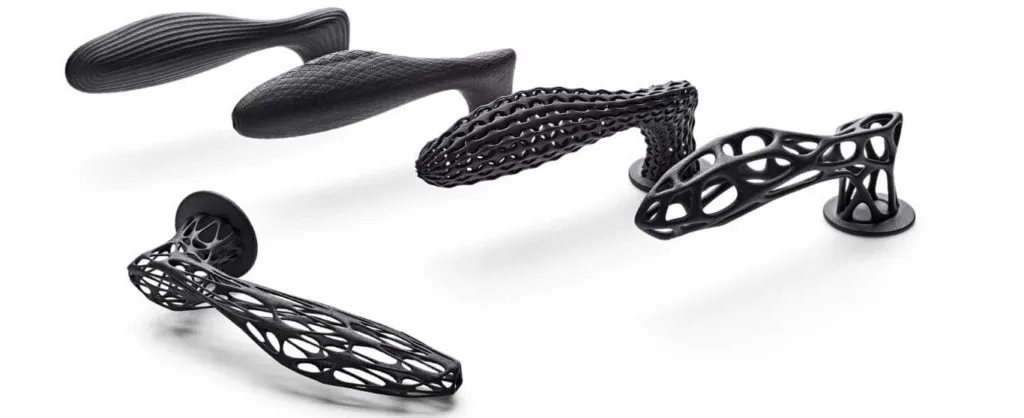
3D models are already required for modern subtractive manufacturing processes or for the production of molds. However, there are still limitations in terms of design freedom. With the advent of additive manufacturing, the boundaries of what is possible have also been significantly shifted here. Below, we will present three redesign strategies that will help you maximize the potential of 3D printing.
- Hollowing out solid components
- Lattice structures
- Topology optimization
Pre-considerations for Re-Design
The potentials of 3D printing come into play throughout the entire product development cycle. Here, we want to present strategies on how to optimize an already existing product in terms of weight and cost. Redesigning products is always a cost-benefit question. Four factors determine the feasibility of design adjustments for 3D printing:
- The mechanical stresses on the object.
- The desired production volume.
- The overall size of the object.
- The massiveness/thickness of the object.
In general, the best candidates for a redesign are large/massive objects.
Re-Design Strategies
Various strategies are available for optimizing 3D models for 3D printing. Firstly, there are the automated functions of hollowing out solid bodies and inserting lattice structures into cavities. Secondly, there is a more manual redesign of objects, including the process of topology optimization. The latter is quite complex and time-/resource-intensive.
1. Hollowing out
Hollowing out primarily saves material and binder. If the unused material powder can be removed from the cavity, you’ll also save a noticeable amount of weight. “Escape Holes” are needed for removing the unused material powder. However, material costs are only one cost factor in 3D printing (the other important one is the consumed build space), so cost savings are heavily dependent on the part geometry. Hollowing out works automatically, using software options, making it very quick and easy to perform. However, note that this could potentially change the mechanical load capacity of the object. Hollowing out is bound to sufficiently thick wall thicknesses (minimum recommended is 2 mm, preferably 2.5 mm).
2. Lattice structures
Inserting lattice structures in otherwise solid objects is beneficial for mechanically stressed objects. Mechanical load capacity hardly experiences restrictions compared to the solid variant. Due to the process, slight restrictions in surface quality may occur for wall thicknesses from 10 mm (warping, shrinkage); lattice structures help solve this problem. “Escape Holes” are not needed for this measure; the unused material powder can remain in the construction. If you have questions about this process, contact us.
Before the structures can be inserted, the object must be hollowed out. Both steps can be automatically performed by software. When choosing the lattice structure, you have several options to choose from (truss, organic structures, honeycombs, etc.), and you can use them according to your requirements. Three important aspects for choosing the most suitable lattice structure are:
- Geometry: The design of the individual “cells” of the lattice determines the possible load distribution and thus the mechanical properties of the entire structure.
- Cell size: The larger the cells forming the lattice, the fewer are needed, i.e., the weight reduction is greatest, but so is the loss of mechanical stability.
- Strut thickness: The thicker the struts of the lattice are, the more stable it is. However, it also becomes heavier/more expensive.
Implementing lattice structures takes slightly more time and brings slightly lower cost/weight savings compared to pure hollowing out. However, the mechanical properties remain virtually unaffected.
3. Topology Optimization
When is Re-Design Worth It?
Decision tree for when re-design is worth it.
Choosing the Best Re-Design Strategy
Once you’ve decided that a product needs to be optimized for 3D printing, consider the following four aspects when choosing the right strategy.
- Mechanical properties: Hollowing out is only advisable for objects subjected to high mechanical stress in a few cases. Therefore, knowledge of the object’s use and load is important from the outset.
- Object’s massiveness: The more massive the components are, the more worthwhile hollowing out and inserting lattice structures become. For delicate objects, topology optimization or manual redesign is more worthwhile.
- Load distribution of the object: If the load distribution is very simple or not critically relevant, the time- and cost-effective automatic hollowing out or insertion of lattice structures is usually sufficient. The more complex load distributions or non-standardized geometries usually justify the more elaborate manual redesign and topology optimization.
- Production volume: The larger the production volumes, the more worthwhile the redesign, even for less suitable components.
About 3Faktur: 3Faktur specializes in 3D printing, rapid prototyping, and rapid manufacturing. We utilize HP’s Multi Jet Fusion technology and offer various materials for prototyping and series production. If you have any questions about your project, feel free to contact us.